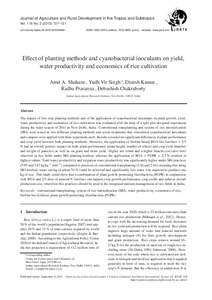| dc.date.accessioned | 2015-09-14T13:05:37Z | |
| dc.date.available | 2015-09-14T13:05:37Z | |
| dc.date.issued | 2015-09-08 | |
| dc.identifier.issn | 1612-9830 | |
| dc.identifier.issn | 2363-6033 | |
| dc.identifier.uri | urn:nbn:de:hebis:34-2015061048464 | |
| dc.identifier.uri | http://hdl.handle.net/123456789/2015061048464 | |
| dc.language.iso | eng | |
| dc.publisher | Kassel University Press | ger |
| dc.rights | Urheberrechtlich geschützt | |
| dc.rights.uri | https://rightsstatements.org/page/InC/1.0/ | |
| dc.subject | conventional transplanting | eng |
| dc.subject | system of rice intensification (SRI) | eng |
| dc.subject | water productivity | eng |
| dc.subject | economics of rice | eng |
| dc.subject | biofilm bio-fertiliser | eng |
| dc.subject | plant growth promoting rhizobacteria (PGPR) | eng |
| dc.subject.ddc | 630 | |
| dc.title | Effect of planting methods and cyanobacterial inoculants on yield, water productivity and economics of rice cultivation | eng |
| dc.type | Aufsatz | |
| dcterms.abstract | The impact of two crop planting methods and of the application of cyanobacterial inoculants on plant growth, yield, water productivity and economics of rice cultivation was evaluated with the help of a split plot designed experiment during the rainy season of 2011 in New Delhi, India. Conventional transplanting and system of rice intensification (SRI) were tested as two different planting methods and seven treatments that considered cyanobacterial inoculants and compost were applied with three repetitions each. Results revealed no significant differences in plant performance and crop yield between both planting methods. However, the application of biofilm based BGA bio-fertiliser + 2/3 N had an overall positive impact on both, plant performance (plant height, number of tillers) and crop yield (number and weight of panicles) as well as on grain and straw yield. Higher net return and a higher benefit-cost ratio were observed in rice fields under SRI planting method, whereas the application of BGA + PGPR + 2/3 N resulted in highest values. Total water productivity and irrigation water productivity was significantly higher under SRI practices (5.95 and 3.67 kg ha^(-1) mm^(-1)) compared to practices of conventional transplanting (3.36 and 2.44), meaning that using SRI method, water saving of about 34 % could be achieved and significantly less water was required to produce one kg of rice. This study could show that a combination of plant growth promoting rhizobacteria (PGPR) in conjunction with BGA and 2/3 dose of mineral N fertiliser can support crop growth performance, crop yields and reduces overall production cost, wherefore this practices should be used in the integrated nutrient management of rice fields in India. | eng |
| dcterms.accessRights | open access | |
| dcterms.bibliographicCitation | In: Journal of Agriculture and Rural Development in the Tropics and Subtropics. Kassel : Kassel University Press. - Vol. 116, No. 2 (2015), S. 107-121 | |
| dcterms.creator | Shahane, Amit A. | |
| dcterms.creator | Singh, Yudh Vir | |
| dcterms.creator | Kumar, Dinesh | |
| dcterms.creator | Prasanna, Radha | |
| dcterms.creator | Chakraborty, Debashish | |
| dc.description.everything | Gedruckte Ausg. im Verlag Kassel Univ. Press (www.upress.uni-kassel.de) erschienen. | ger |

